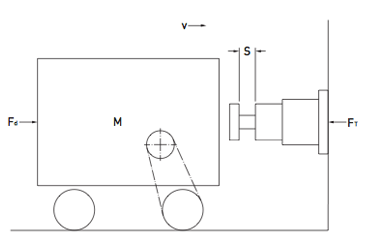Leading the world in
energy absorption

| Kinetic energy to be absorbed |

|
| Energy due to drive force to be absorbed | Ed = FdS |
| Total energy to be absorbed | ET = Ek + Ed |
| Maximum impact force due to inertia |  |
| Total maximum impact force Design mass for buffer | FT = Fi + Fd |
| Design mass for buffer |  |
To avoid confusing conventions within calculations always use SI units in formulae then convert to more appropriate units if required.
| Notation | Quantity | SI Unit |
| M | Mass of body | kg |
| Me | Buffer design mass | kg |
| S | Buffer stroke | m |
| Ek | Kinetic energy | J |
| Ed | Energy due to drive force Total energy | J |
| ET | Total energy | J |
| v | Velocity | m/s |
| Fi | Inertial force | N |
| Fd | Drive force | N |
| FT | Total force | N |
| n | Number of buffers in parallel | - |
| ξ | Efficiency | - |
Eg. Consider a body of mass M = 20000kg (20 tonnes), moving at a velocity (v) of 1.5m/s with a drive force (Fd) of 20kN (20000N).
To find energy absorbed:
Ek = 1/2 Mv2 = ((20000kg)x(1.5m/s)2)/2 = 22500J = 22.5kJ
Let us therefore select a Type21-150
Ed = Fd.S = 20000N x 0.15m = 3000J = 3kJ
Total energy to be absorbed
ET=Ek+Ed=22500J+3000J=25500J=25.5kJ
To find the maximum impact force:
Fi max = Ek / (S. ξ) = 22500J / (0.15m)x(0.8) = 187500N = 187.5kN
Fd max = 20000N = 20kN
F T max = F i max + F d max = 187500N + 20000N = 207500N = 207.5kN
To find buffer design mass for metering pin selection:
Me = 2.ET / (n.v2) = 2 x 25500J / (1 x (1.5m/s)2 = 22667kg = 22.667 tonnes
Select a Type 21-150 buffer with a dynamic capacity of 30kJ and a maximum permissible load of 250kN, to meet these requirements.Therefore select metering pin code 155, for masses up to 25000kg (25 tonnes).